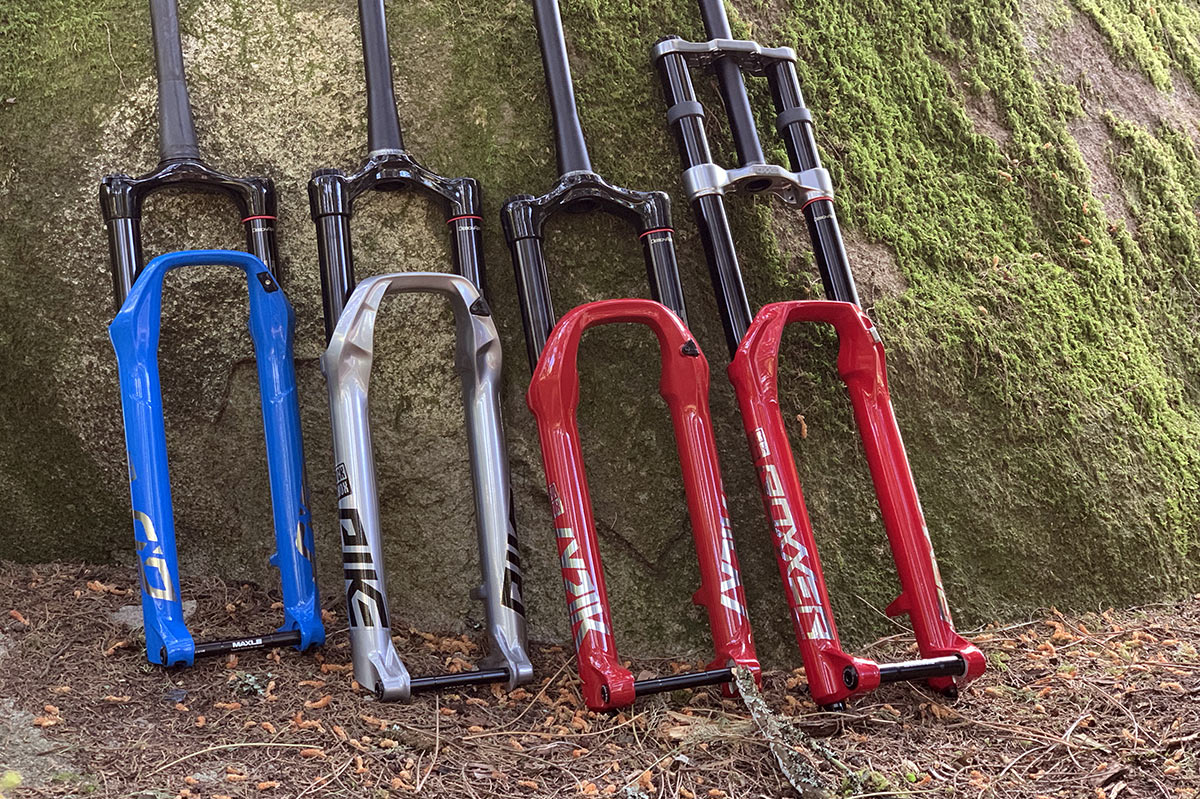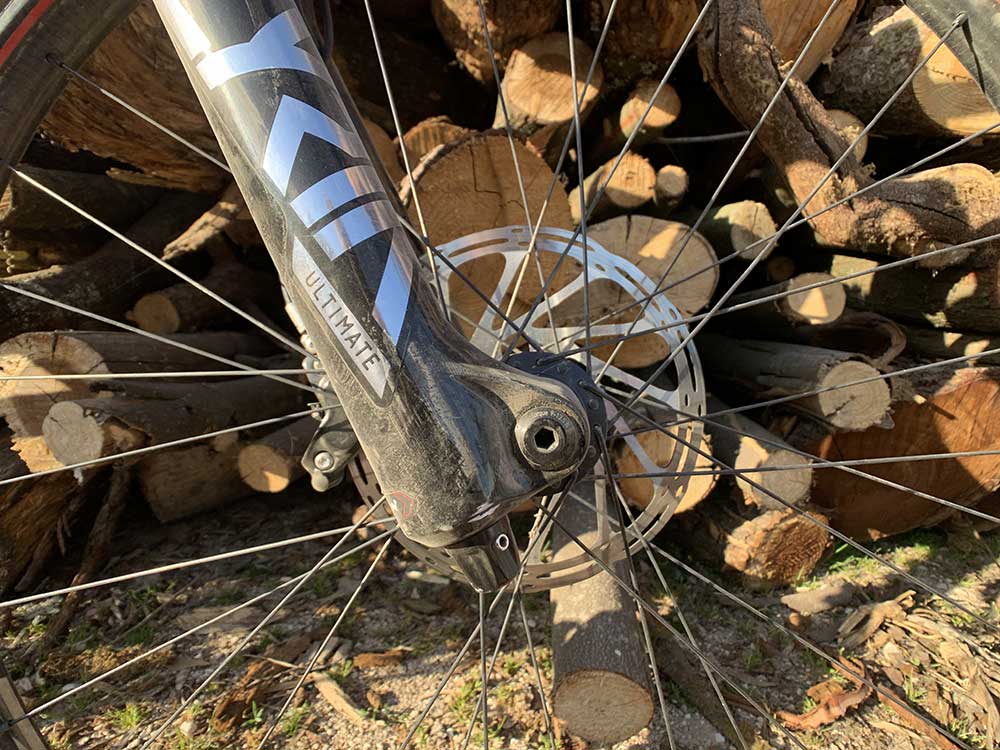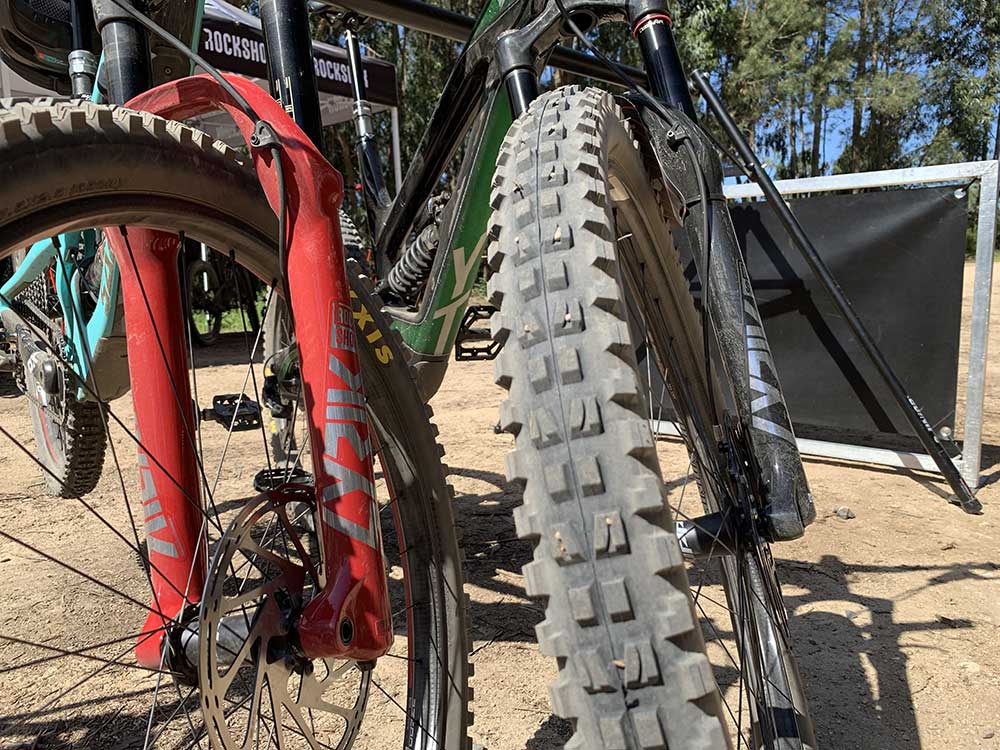For the past few years, Rockshox has been focused on making marginal gains in internal performance. First there was the addition of the larger DebonAir negative air spring design. Then refinements to the surface treatments to reduce friction. Now, for MY2020 forks, they’ve tweaked the seals, grease, oil and Charger 2 damper system to make the forks smoother than ever. And with the changes to the compression and rebound damping, they claim to sit higher in the travel, handle bigger hits better, and recover more precisely. Which is a lot considering the outsides haven’t changed at all, other than stickers and paint. So let’s start there…
Rockshox Signature Series brings a new naming scheme…
Rockshox’s premium models are the SID, Pike, Lyrik, and Boxxer, between them covering all travel ranges and use cases. For 2020, those four shall be known as the Rockshox “Signature Series”, helping identify them as top tier options above lower-priced equivalents (Sector, Recon, Reba, Revelation, 35, etc).
Each model also gets new name rankings: Ultimate at the top with special paint and finish, then Select+, then Select. All in an effort to better differentiate the models with something other than damper-based naming schemes like RC/RT3/RC2. Those letters and numbers may be more descriptive, but they don’t immediately indicate which model is better. So…the names indicate the level of technology inside the forks, not the specific damper.
Ultimate and Select forks will be available aftermarket, the former getting all the external controls and doodads, the latter getting basic low speed rebound and compression. Select+ is going to be mostly an OEM option. For rear shocks, it’s pretty much only Ultimate for aftermarket…more on those in this post.
All Ultimate forks get model-specific signature colors (gloss blue for the SID, gloss silver for the Pike, gloss red for the Lyrik and Boxxer). There’s a new gloss piano black for all of them, too.
Select and Select+ still get some of the same colors, like a blue SID, but the Ultimates will get glossier higher quality finishes. If you note their history, most of these signature colors go way back to these models’ original colors when they launched.
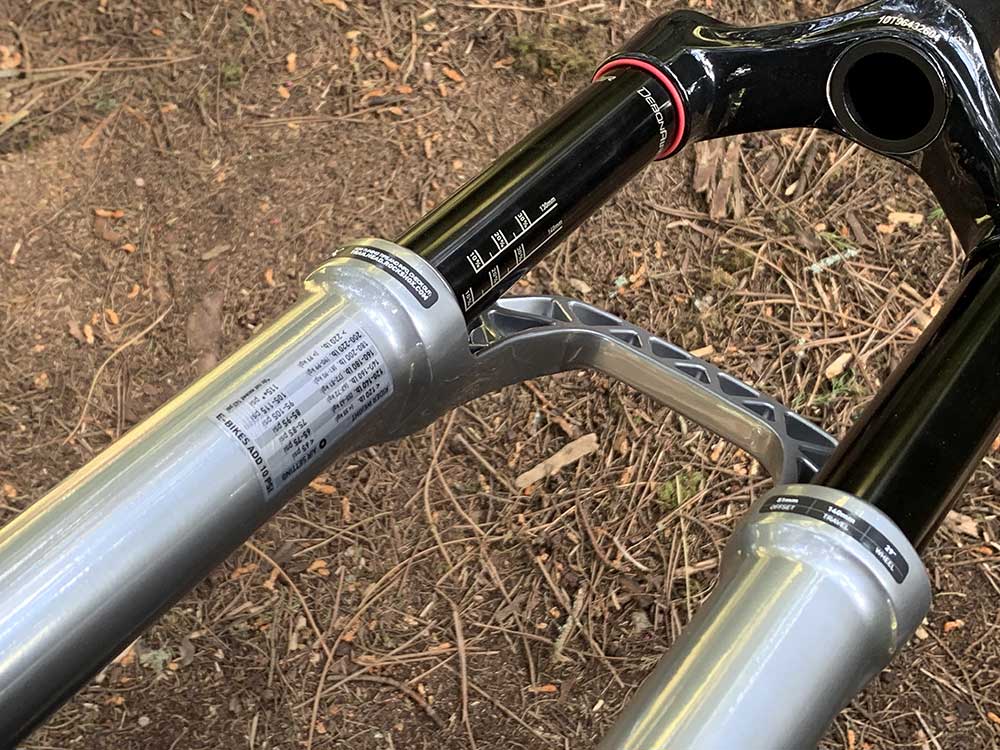
TL;DR – What’s the deal?
In a nutshell, the MY2020 Rockshox lineup upgrades their top-level forks in each travel category with drastically reduced friction so they move more smoothly. There’s also Charger 2.1, which is a heavily updated damper for the Pike, Lyrik, and Boxxer that helps it stay higher in the travel, compress more smoothly and rebound with more control. The goal? Help those forks stick a landing and stay glued to the ground no matter how big the hit or drop. Oh, and to keep your hands and arms feeling fresh even on long descents. The SID sticks with a more XC-oriented damper that will offer a firmer climb/lockout setting. The lowers, stanchions, crown and steerer all carry over unchanged, which means all these new guts can be put into older forks when you want to upgrade.
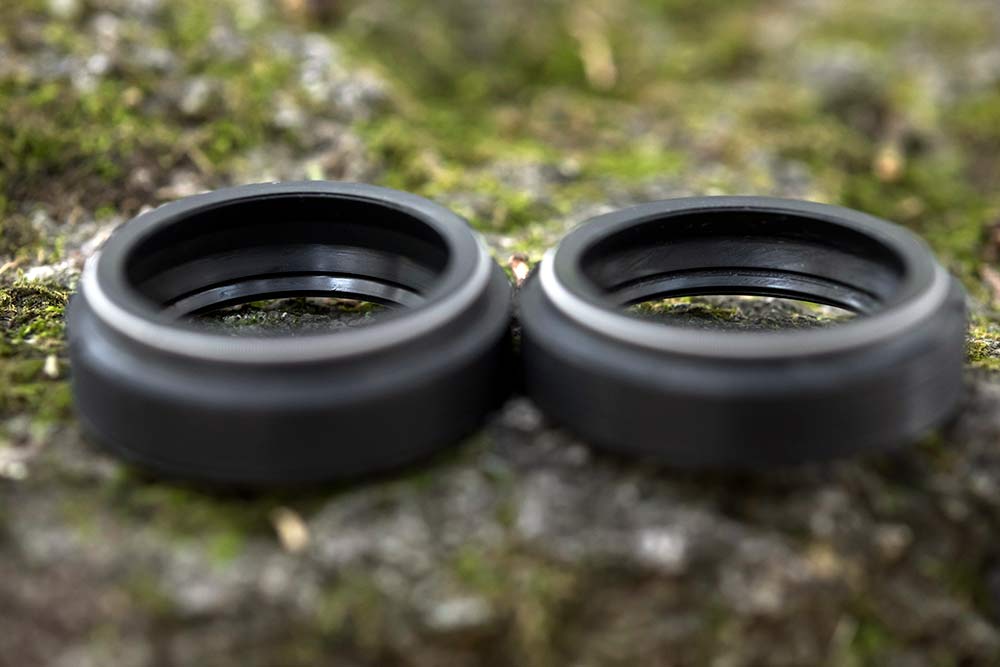
OK, I guess I’d like some details.
In 2018, they introduced updated forks and shocks with strategic materials improvements to reduce friction and make everything smoother, but they received some feedback that the ride was a little harsh. Or that the ride height under light compression needed to be improved. And they’re always still working to reduce friction further. So, they went back to the drawing board, armed with that feedback, to make a fork that wasn’t just smooth, but also performed the way modern riders wanted.
Maxima gave them a new, more slippery oil, a little of which is now added to the air chamber to lubricate that piston seal. Then SKF gave them new seals to reduced friction, using a design based off prototype tech from their moto racing program. Both delivered reduced stiction on their own, but combined it makes an immediately noticeable improvement. The better news? Both the oil and the seals will be available aftermarket and can retrofit to prior generation forks.

How are the seals different?
For their pro racers, Rockshox had been removing the small coil spring on the underside of the wiper seal, and sometimes tweaking the lower lip seal. They could get away with this because pros’ forks are serviced after each race, so keeping all the oil in for months or years wasn’t important for them like it is for us. Doing so reduced stiction and friction a lot, so for World Cup races where tenths of a second count, it was worth it.
Rockshox wanted those benefits for production forks, so SKF revised the seal geometry to minimize surface contact on the upper tube. Basically, it’s a production version of their racing seals that’s also able to keep grease and oil inside the lowers. Win, win, right? And yes, they keep the little springs…you probably shouldn’t remove them.
Cool. What else?
They also worked with SKF to develop a better internal seal for the damping cartridge. Here, they wanted to minimize “breakaway” friction, which works in both directions and is essentially the friction spike that occurs when it changes direction between compression and rebound. All told, they say the updates reduced friction a whopping 30%.
On the air side, the actual air spring is the same. But, they’ve started using the same green Dynamic Grease inside the forks that they’ve been using on the shocks for the past couple years. This grease is about the same slickness as the grease they were using in the forks, but it lasts longer before breaking down into oil.
Sounds slick, is there more?
Yes. The friction stuff was the low hanging fruit compared to the next part: damping.
After hundreds or thousands of test rides, their data acquisition told them they needed to reduce high speed compression damping. So, they reduced it to the absolute minimum, letting the fork “get out of the way” on big hits. Why? Any harshness transmitted by the fork goes first to your hands, then your arms, then your shoulders and body. If you can reduce this, the most noticeable benefit is less hand fatigue and soreness.
To accomplish this, they changed the way the shim stack, piston bolt, piston and low speed needle work together. The result is Charger 2.1.
For low speed compression, they also tweaked the upper limit (meaning, the highest amount of compression) to the point where they say you can run it all the way “closed” and still have a very supple fork. All of that is great, but it’s all happening inside that damper cartridge shown above, so we can’t see it. But…

On the flip side, they updated the rebound circuit to keep the fork riding higher in it’s travel over rough terrain or immediately after a big hit, What was happening was that, on really big hit, a little bit of oil could slip past the slit in the rebound piston (white, on right). That meant the fork wouldn’t recover as quickly as it should, maybe even bouncing a bit. The new version uses a new piston wear band (aka “seal”, orange on left), which means no oil can slip past, so all oil is routed through the damping circuit. Naturally, this gives them more control over what that oil is doing and, thus, your ride. The orange material is the same stuff they’ve used in rear shocks, so it’s only new to forks.
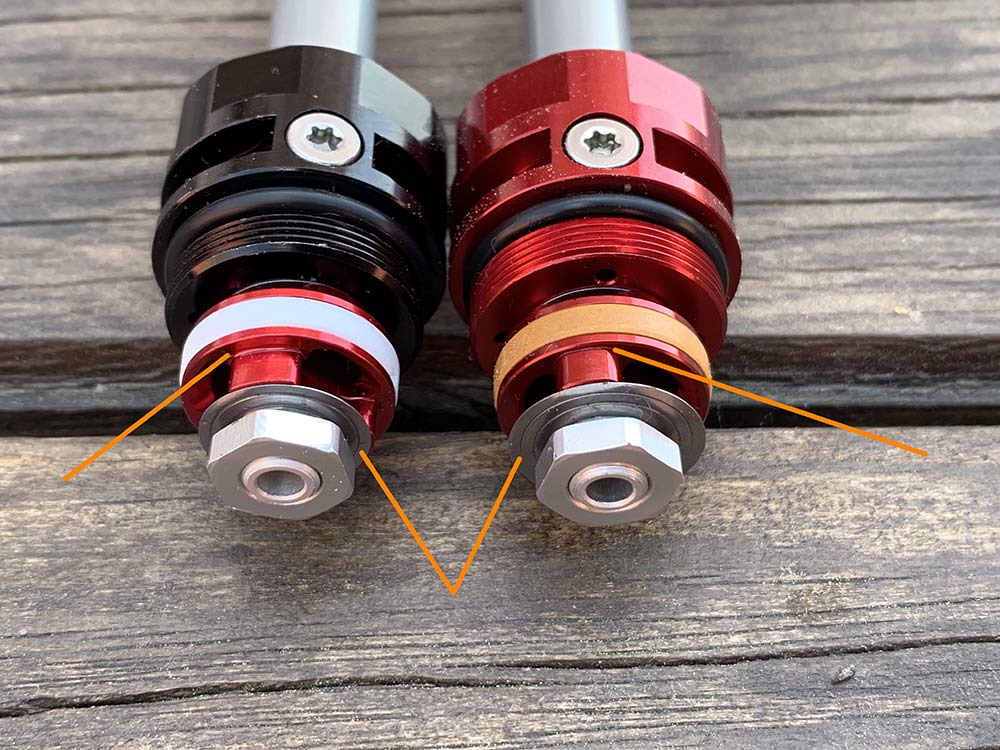
Inside that circuit, they also changed the oil flow path through the piston so that it would create less resistance during high speed, and it gets a new, more robust shim stack. Put simply, it’ll perform the same as their prior Rapid Recovery high speed rebound circuit, it’s just set up a little differently to improve overall fork consistently and reduce or eliminate successive bounces by better controlling the rebound speed.
The goal was to keep the wheel tracking better, with a particular emphasis on helping it “stick” a landing and immediately grab and follow the terrain.
The Ultimate Pike, Lyrik and Boxxer will all use the new Charger 2.1 damper with RC2 system, meaning you’ll have external high and low speed compression damping, and external low speed rebound.
Remind me, what’s the Charger?
The Charger damper has two versions, the bladder-based model that uses pressure from an expanding bladder, and one that uses a gas-backed IFP instead. Both accomplish the same thing, keeping pressure on the system to help push oil back through the circuit during rebound and prevent air bubbles from forming. The CHARGER 2.1 is the higher-end bladder model, and you’ll find that on forks with the RC2 and RCT3 controls, mostly Ultimate and Select+ forks. The base-level Charger RC is what’s on Select forks.
What about the 2020 Rockshox SID?
The SID Ultimate is the only fork in their signatures series that does not get the new Charger 2.1 damper because it’s more XC-focused. The Ultimate gets RLC (rebound, low-speed compression, and on/off lockout), instead, and keeps the Charger 2 setup.
The SID Select, however, gets a new Charger RL damper. New, in that it’s actually the first time they’ve offered a “base level” SID. And a base level Pike and Lyrik, for that matter, though those will have different dampers. But for the SID, the new Select level damper gets their IFP based damper with a simple two position low speed compression switch.
What else should I know?
Most of these new changes, from the seals to the grease to the oil to the Charger 2.1 damper are all backwards compatible for several prior generations of their forks. The new damper is $250/€280/£250 for Pike and Lyrik, and $375/€415/£370 for the Boxxer.
The Trailhead program that’s lived on their website is coming as a smartphone app, too, starting with forks. Use that to help you set up the air pressure and damping to a good baseline, then tweak from there and record your measurements.
But I want specs! And prices!

2020 Rockshox SID
- 100/120mm travel
- 32mm stanchions
- 29er has 42mm and 51mm offsets
- 27.5 has 42mm offset
- Ultimate Carbon: Charger 2 RLC ($999-1,079 / €1,110-1,200 / £990-1,070)
- Ultimate: Charger 2 RLC ($779-849 / €865-945 / £75-840)
- Select+: Charger 2 RL (OEM)
- Select: Charger RL ($599-699 / €665-745 / £595-665)
- Weights from 1,481g to 1,582g by model (claimed, 27.5″, 100mm travel)
2020 Rockshox Pike
- 120/130/140/150/160mm travel options using two different air springs, but same uppers and lowers. If you want to go from the shortest range to longest, or vice versa, you’ll need to swap air springs. But smaller changes happen with spacers.
- 35mm stanchions
- 29er has 42mm and 51mm offset options
- 27.5 has 37mm and 46mm offset options
- Ultimate: Charger 2.1 RC2 or RCT3 damper options ($929 / €1,030 / £920)
- Select+: Charger 2.1 RC (OEM)
- Select: Charger RC ($699 / €775 / £695)
- Weights from 1,825g to 1,832g by model (claimed, 27.5″, 120mm travel)
2020 Rockshox Lyrik
- 150/160/170/180mm travel options
- 35mm stanchions
- 29er has 42mm and 51mm offset options
- 27.5 has 37mm and 46mm offset options
- Ultimate: Charger 2.1 RC2 or RCT3 damper options ($999 / €1,110 / £990)
- Select+: Charger 2.1 RC (OEM)
- Select: Charger RC ($699 / €775 / £695)
- Weights from 1,996g to 2,003g by model (27.5″, 150mm travel)
2020 Rockshox Boxxer
- 180/190/200mm travel options
- 35mm stanchions
- 29er has 46mm and 56mm offset options
- 27.5 has 36mm and 46mm offset options
- Straight 1-1/8″ steerer tube
- Ultimate: Charger 2.1 RC2 ($1,699 / €1,890 / £1,685)
- Select: Charger RC ($1,309 / €1,455 / £1,300)
- 2,565g claimed weight (Ultimate, 27.5″, 200mm travel)
All Euro and BP pricing include VAT.
We brought the scale along, but it proved difficult to get the forks to sit on it…a hanging scale would be better. But, here’s what we got by hanging them off the end, all forks are Ultimate level with full length, uncut steerer…not sure which travel or wheel size.
- SID: 1,412g
- Pike: 1,887g
- Lyrik: 2,051g
- Boxxer: 2,607g
All of Rockshox’s claimed weights include the axle, so the variation above (or below, for the SID!) claims could simply be due to the way we’re holding the scale, or because they’re still using a full length steerer tube. Or because the show forks were using the longer travel air springs. Most likely it’s a combination of all three.
Check out the new MY2020 Deluxe, Super Deluxe and Super Deluxe Coil rear shocks in this post. Stay tuned for first ride reviews of the 2020 Pike!
